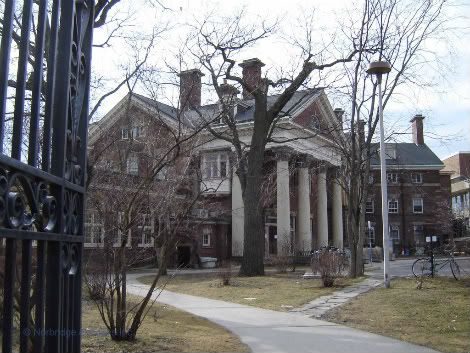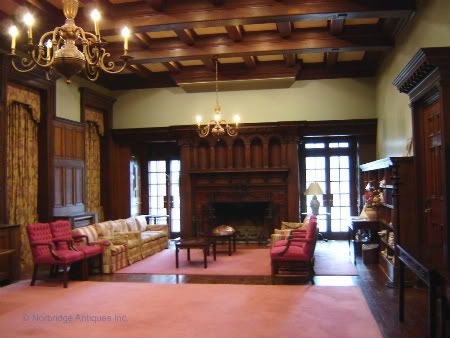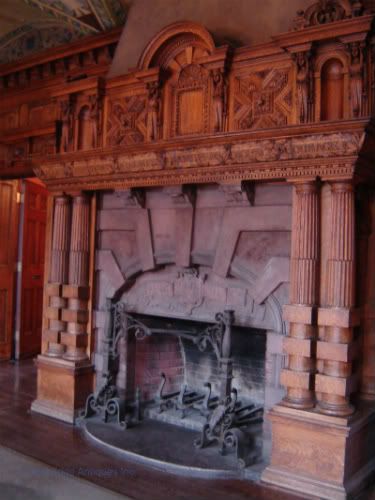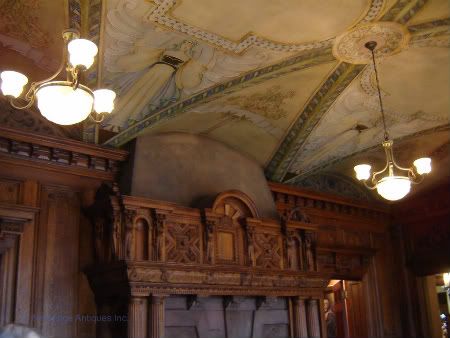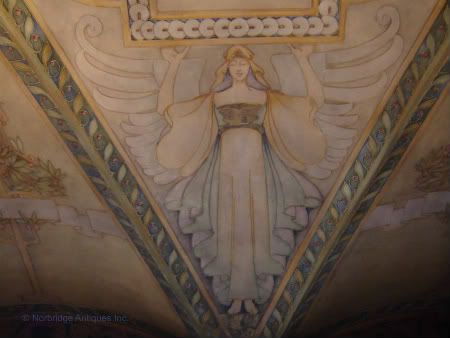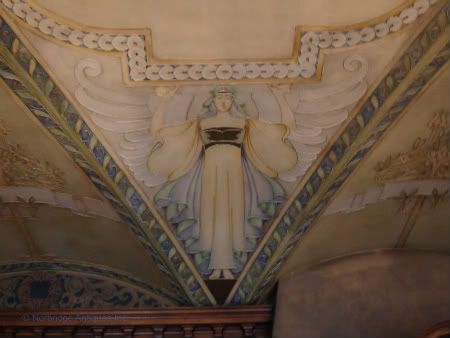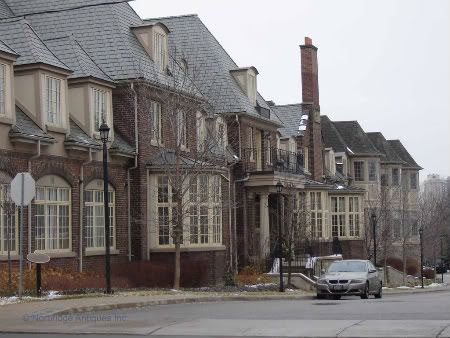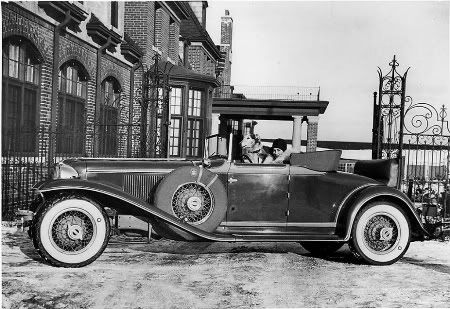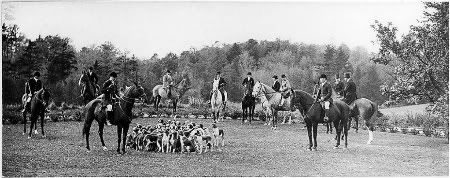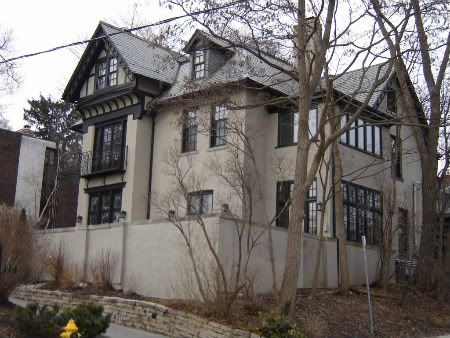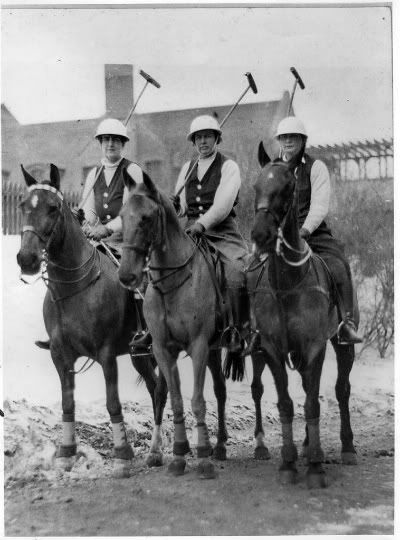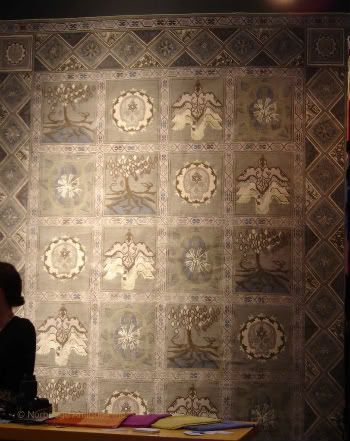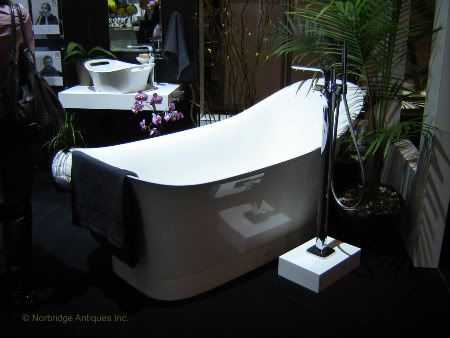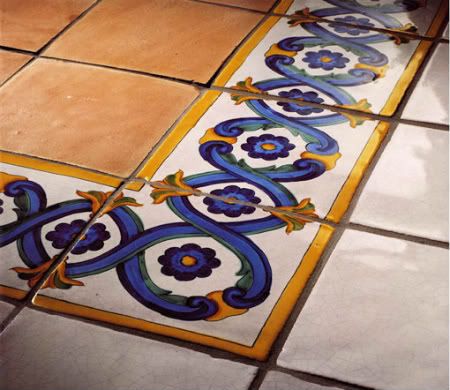 |
| Fireplace in the Matthews House panelled ballroom designed by Gustav Hahn, 1899. |
The historic houses in Toronto are a reminder of the business, industry, and banking leaders who influenced the shaping of Canada; and of the great architects and artists who added to its rich, distinctive culture. One of Canada’s
distinguished artists is Gustav Hahn (1866 – 1962), painter and sculptor. Trained
in Germany and Italy, Gustav Hahn already had extensive experience in European
art when he immigrated to Canada with his family in 1888. He came here just as the Art Nouveau movement was beginning to become highly popular. His
talent was immediately recognized as he set to work painting panels, and designing
furniture and other home furnishings for the houses of prominent Toronto
citizens. At this time he also designed theatre façades, curtains, and proscenia. He soon became Canada’s most important artist working in the Art Nouveau style.
 |
| Ceiling by Gustav Hahn, 1892. Ontario Legislative Chamber, Ontario Legislative Building. |
In 1892, Gustav was
commissioned to paint murals on the upper walls and ceiling of the Legislative
Chamber of the brand new Ontario Legislative Building. His completed murals of allegorical figures
signifying Justice, Moderation, Power, and Wisdom, and the symbolic design on
the ceiling were received with much pleasure.
For some unknown reason, in 1912, his murals and ceiling were covered
with several coats of paint. During the refurbishment
of the Chamber in 1994, the artwork was discovered and a meticulous restoration
of the murals and the ceiling began.
Gustav’s ceiling painting of gold and brown maple leaves on a green background
has now been exposed. The work on the murals
is progressing, but is not yet complete because this can be done only while the
House is in recess.
 |
| A portion of the frieze recognized as being Gustav Hahn's work, 1898. Billiard room of Spadina House. |
Though unsigned, the rhythmic, stunning Art Nouveau frieze of 1898 on the walls of the billiard room of
Spadina House is recognized as being Gustav Hahn’s work.
 |
| Panelled Ballroom designed by Gustav Hahn, 1899. |
In 1899, Gustav decorated the one-story Art Nouveau panelled ballroom of the Matthews House at 89 St. George
Street, now the Newman Centre at the University of Toronto. The fireplace is pictured at the beginning of this post.
 |
| Ceiling by Gustav Hahn, 1902. Flavelle House. |
In 1902, Gustav painted
the exquisite Art Nouveau ceiling in the elegant Georgian Great
Hall of Flavelle House, now part of the University of Toronto Law School.
Without a doubt, Gustav’s
greatest masterpiece was his magnificent ceiling of St. Paul’s Methodist Church
on Avenue Road, painted in 1890. He
covered the entire ceiling with angels, lilies, and vines in his graceful Art
Nouveau style. Unfortunately, a fire
occurred in 1995 destroying the entire church that resulted in an enormous loss
to the art world.
His other work in private
and public buildings came from private commissions, and those he received
through the design firm Elliot and Son. Gustav’s
work includes a frieze for the Bank of Nova Scotia at Yonge and Bloor Streets,
a mural for the Central Methodist Church, a spandrel for the Bank of Nova
Scotia, the curtain and proscenium for Shea’s Theatre, decorations in the
chancel of St. John the Evangelist in Montreal, the ceiling over the main altar
of St. James Cathedral, Truth and Justice at the Toronto old City Hall, and a
stained glass window over the altar of Calvin Presbyterian on Delisle Avenue. It is heartbreaking to note that a great deal
of his work in private and public buildings has been lost due to renovations
and demolitions as the city expanded.
Gustav worked prolifically
throughout his long career. His list of
memberships was long: the Society of Painter-Etchers
and Engravers, the Canadian Society of Applied Art, the Toronto Arts and Crafts
Society, the Arts and Letters Club, the Ontario Society of Artists, and the Royal
Canadian Academy. Gustav showed his creations at art exhibitions
all over Canada. Several of his
paintings and drawings are now in the National Gallery of Canada permanent
collection. For many years until he was
80 years of age, he was a teacher at the Ontario College of Art where he taught
some who would later become important artists.
Despite a hectic teaching schedule and working on commissions, he found
time to teach additional classes at the Royal Ontario Museum, and at Toronto’s Central
Technical School. Through his work and
his teaching,
Gustav Hahn has left an outstanding legacy.
 |
| A portion of the ceiling by Gustav Hahn, 1902. Flavelle House. |

